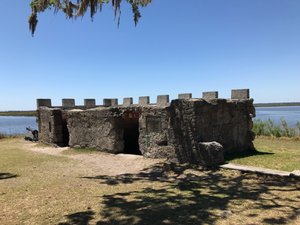Advertisement
Published: April 22nd 2017

 IMG_0532
IMG_0532
All that remains of Fort Frederica - a magazineFort Frederica National Monument, Frederica, Georgia
Archaeology might best be described as the scientific imagination. The ruins of Fort Frederica are really not much. There is a single room still standing - a magazine from the original fort. Otherwise all you can see anywhere in the fort or its supporting town are faint outlines of foundations.
But out of a substantial effort at recovering artifacts, and comparing them to what written records are available, archeologists have been able to reconstruct a pretty good model of what the fort and the town looked like. And the Park Service has developed a very good method of conveying that model by walking you through the grounds using interpretive signs and a telephone recording where you punch in your stop number and a narrator tells you what is going on at that site.
Apparently the breakthrough happened when the scientists unearthed a 'common wall', dividing two houses - a 'duplex' in modern terms. The written records identified only one such shared housing situation and so, starting with that location, they were able to make out all 76 housing units in a neat little quadrant system with 'Broad Street', 'Cross Street' and several

 IMG_0522
IMG_0522
Trees now lining Broad Street in the Townlittle alleys. Then they were able to identify which houses belonged to which families using those written records, as well as artifacts specific to the known trades of the families occupying those units. They found candle-making utensils in the candle-makers house, barrel remnants in the coopers, house, and even broken tankard remnants at the site where the tavern owner was (next door to the apothecary). There was even a stratification system with the houses 'below' Cross street being notably smaller than those 'above'. The walk around the leveled town was really quite fascinating, although it required a huge amount of imagination.
With so little to actually see here, this monument is entirely different than the other forts we've seen on this trip. Fort Jefferson, with its 16 million bricks, or Castillo de San Marcos, with 19 foot walls, were palpable examples that you could touch and see. Fort Frederica, though, has been gone for some time, so the experience isn't visual or tactile, but more in the mind.
There is also some important history here. The Fort and the town are really two parts of a single unit. Yes, the fort guarded the town, and the town was

 IMG_0520
IMG_0520
Live Oak and Spanish Mosswholly contained within walls that included the fort. But the fort relied on the town, and the skills the town people possessed.
James Oglethorpe was an English aristocrat who was seeking a solution to the massive English problem of thousands of poor people without jobs. He envisioned a solution by finding them a new place in the Americas and in 1732 King George granted his board of trustees all the land between the Savannah and Altamaha rivers (basically what we know as the state of Georgia). Although Oglethorpe may have had some altruistic motives, King George was probably looking for a way to shield his northern colonies from intrusions by the Spanish in Florida. Oglethorpe began building the settlement at Savannah the following year.
Realizing that he would need to protect his settlement from the Spanish, he sailed south down the coast before locating the ideal location for an 'early warning system' at St. Simons Island. Reasoning that the Spanish would most likely sail up the inland waterway, he positioned Fort Frederica at a bend so it would have a commanding view of the possible line of attack and would be able to blast Spanish ships well before

 IMG_0518
IMG_0518
Tabby - a mixture of oyster shells, sand, and limestone.they got to Savannah.
In 1734 construction started on the fort and the town grew up around it. Eventually about 500 people lived and worked in the little settlement. Oglethorpe went back to England and arranged from some 630 British regular troops to come permanently man Frederica and a smaller fort at the southern tip of the island, Fort St. Simons, as a bastion to stop the Spanish from taking Georgian territory.
Then he got a little overconfident. In 1740 he sent 2000 troops and Indian allies down to St. Augustine and laid siege against the Castillo de San Marcos. He had zero luck breaching the defenses of that castle and finally had to give up. Two years later Spain took the initiative and with 2000 men, began an assault on Georgia. A column of men advanced on Frederica, but were beaten back in the Battle of Bloody Marsh, near the town and fort. Oglethorpe had successfully defended Georgia from the Spanish assault.
Spain eventually lost the war and, the threat gone, the reason for Fort Frederica disappeared. The town did too by 1755. It took concerted conservation work, two centuries later, to bring it back to

 IMG_0528
IMG_0528
House Remainslife.
After touring the park, we drove down south, towards the prior location of Fort St. Simons and ate a good seafood lunch at Gnat's Landing. Nowadays, this part of Georgia is home to large, glamorous homes, amid oak trees dripping with Spanish moss. Very beautiful and worth a day's excursion. (17.1.45)
Advertisement
Tot: 0.235s; Tpl: 0.011s; cc: 11; qc: 48; dbt: 0.1044s; 1; m:domysql w:travelblog (10.17.0.13); sld: 1;
; mem: 1.1mb











